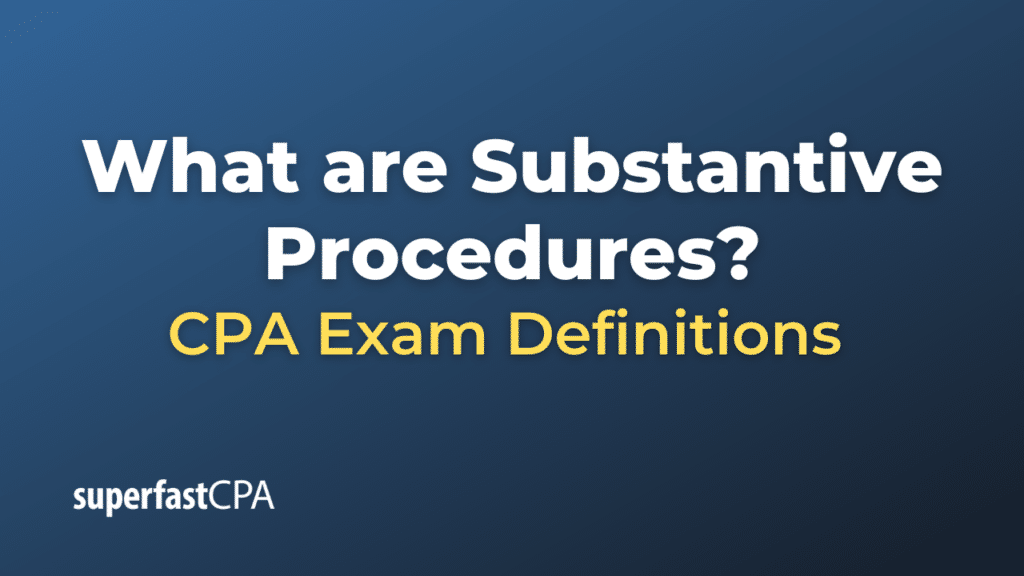Substantive Procedures
Substantive procedures, in the context of auditing, refer to the specific tests and procedures that auditors perform to obtain evidence about a company’s financial statements, ensuring they are free from material misstatement. These procedures help the auditor form an opinion on the truth and fairness of the financial statements.
Substantive procedures can be classified into two main types:
- Tests of Details: These focus on the details of specific transactions, balances, and disclosures. They aim to uncover errors or misstatements in specific financial statement items. Examples include:
- Confirming accounts receivable balances with customers.
- Examining vendor invoices to verify accounts payable balances.
- Physically counting inventory items and reconciling the count to inventory records.
- Verifying the valuation of assets by examining supporting documents or calculating depreciation.
- Substantive Analytical Procedures: These involve evaluating financial information by studying plausible relationships among different sets of data. Instead of verifying individual transactions, they look at patterns and trends. Examples include:
- Comparing current-year sales to prior-year sales and investigating significant fluctuations or trends.
- Assessing the reasonableness of depreciation expense based on the company’s historical depreciation rates and new asset purchases.
- Comparing a company’s financial ratios to industry averages.
- Reviewing the relationship between payroll expenses and the number of employees.
The choice and mix of substantive procedures depend on the auditor’s risk assessment, the nature of the client’s business, and the specific areas in the financial statements that might be at risk of material misstatement.
To clarify, substantive procedures are distinct from “tests of controls”. While tests of controls assess the effectiveness of a company’s internal control system, substantive procedures directly examine the actual financial data to verify its accuracy and completeness.
Example of Substantive Procedures
Let’s delve into a practical example of substantive procedures in the context of auditing a fictional company’s inventory:
Company: Elegant Fashion House
Scenario: Elegant Fashion House is a clothing manufacturer and retailer. During the year, it introduced a new line of clothing, and there have been significant changes in the sales and inventory figures compared to the previous year.
Objective: As an auditor, you want to ensure that the inventory stated on the balance sheet is accurate and not materially misstated.
Substantive Procedures:
- Physical Inventory Count:
- Attend the year-end physical inventory count at the company’s warehouse.
- Observe the counting process to ensure items are being counted accurately.
- Perform test counts on a sample of inventory items and compare your counts to the company’s counts.
- Inventory Valuation:
- Examine invoices for a sample of inventory items to verify the cost recorded in the inventory ledger.
- Test the computation of any inventory write-downs for items that are obsolete or slow-moving.
- Ensure inventory is valued at the lower of cost or net realizable value.
- Ownership and Rights:
- Review inventory consignment agreements to ensure items on consignment are excluded from the company’s inventory balance.
- Investigate any items shipped to customers “on approval” near year-end to determine if they should be included in inventory.
- Completeness:
- Review post-year-end sales transactions to check if any of the sold goods were included in the year-end inventory (they shouldn’t be if they were sold).
- Compare the total quantities of inventory items from the current and previous year. Investigate significant discrepancies or reductions.
- Substantive Analytical Procedures:
- Compare the inventory turnover ratio of the current year with the prior year and industry average. Investigate any significant differences, especially if the turnover has decreased considerably despite increased sales, which could indicate potential overstatement of inventory.
- Assess the gross profit margin. A significant decline might indicate inventory shrinkage or valuation issues.
By executing these substantive procedures, the auditor can gather sufficient appropriate evidence regarding the accuracy, valuation, completeness, and ownership of Elegant Fashion House’s inventory. If discrepancies or issues are found, they’ll need further investigation and may result in adjustments to the financial statements.













